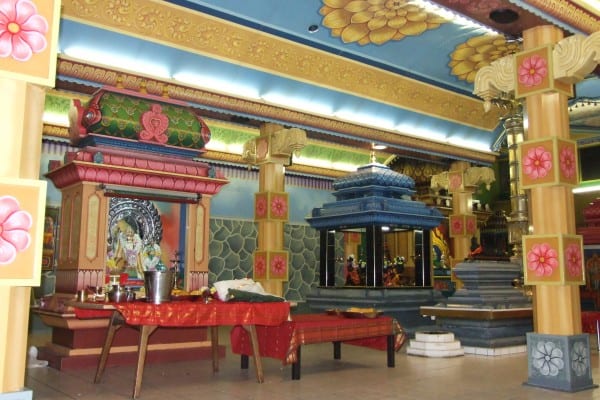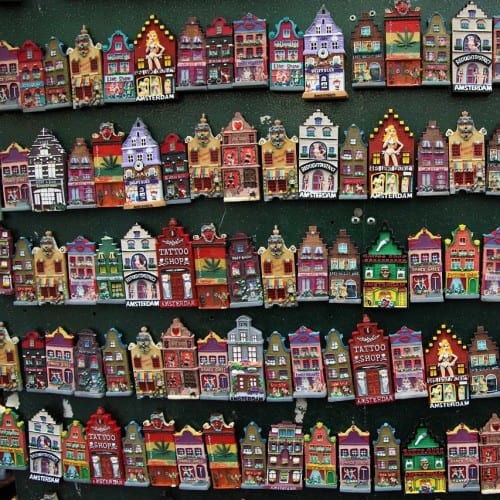I conduct fieldwork among young Hindus in Amsterdam, the city where I have lived for nearly six years. Amsterdam lends itself to compartmentalisation as it is neatly divided up by canals; the boundaries between distinct places and streets seem to be part of the city’s heritage. However, as I have became more engrossed in my fieldwork and reflexive in my approaches, the boundaries that I imagined between my city and my field have became blurry.
What appears on paper as a study of Hindu temples is in fact a project built on a complex intersection of clothing stores, trendy cafes, bars, parks, living rooms and metro cars where the bulk of my ethnographic interviewing has taken place. Many of these places are those in which I socialize with friends and family. In this post I elaborate what this all means for my fieldwork.
I. THE CITY
One warm July evening, I agreed to meet a young female respondent named Jaya [2] in the centre of town to go shopping. We were looking for a bathing suits that she could buy for her upcoming summer vacation. After the third or fourth time that I glanced at my phone distractedly, my respondent asked me, ‘do you need to leave or something?’ I apologised and said no, feigning interest in the row of sundresses behind her.
I was distracted by the fact that my husband had texted me to say he was sitting around the corner on a terrace with a group of friends, and inviting us to join them for a drink. Although Jaya and I often have our conversations on terraces or at restaurants and have made plans for our husbands to meet, I deliberately lead her to a café in the other direction. I tell myself that I am acting out of professionalism rather than anything else – that this was an interview and I needed to maintain certain boundaries. We continue our discussion in a more conventional manner: me with a tape recorder and she responding politely to my inquiries.

This was s major ‘dis-orientalising’ (Gunn 2009, 42) moment of my fieldwork. As Gunn notes in her study of a Hindu community in Ottawa, when she observed a middle class Hindu woman talk about worshipping the banana plant on Thursday, she felt odd and out of place. Surely, this was something that would make sense in a small Tamil village, but not in the city where she lived (2009, 41). Similarly, my panic in having my social life and fieldwork life collide on closer inspection had little to do with professionalism, but more to do with the idea of the city as a compartmentalization of my fieldwork life and social life. Although I pretended to have interest in bridging the two, the idea frightened me as somehow inauthentic.
Unwittingly, I was perpetuating the idea of fieldwork as a journey to unfamiliar places. The possibility of doing fieldwork somewhere familiar, as someone other than a researcher (friend, wife or social animal), was somehow taboo.
I had already seen that people (ironically, mostly those who had never engaged in fieldwork themselves) took my choice to stay in the city where I lived as an easy way out of tropic diseases, isolated villages, mud huts and savage natives that somehow authenticated fieldwork praxis. I was already losing points as a researcher. On the other hand, I was well versed with reflexive and multi-sited field methods that complicated these sorts of static and romantic visions of ‘the field’. Fieldwork was my everyday life. It was not an extended stay, day and night, into the world of a group of people (MacClancy 2002, 4) but an extension of my self in my city.

It was also clear that my respondents would not take my orientalising view of the city as the field very seriously. Although I began by trying to arrange meetings in temple spaces, my young respondents were more enthusiastic to take me to new restaurants and bars in popular parts of the city. I picked my respondents up from work and walked them home at night. I took them to places in the city they had never been, and they showed me parts of the town I had ignored. We guided each other through our city, and at times it was not clear who was leading whom.
II. Dis-Orientalizing
Besides working towards disorientalising Amsterdam as a field site, much work needed to be done in order to dis-orientalise my attitude towards Hindus in the Netherlands. The fieldworker occupies of course always a liminal position, being neither truly inside nor outside a community with which she work. Rather she is constantly embedded and situated, speaking never from a neutral zone of ‘see-all’, but from within her own biases and experiences.
As a diasporic Indian, born in England and raised in Canada, my interpretative lens is necessarily a splintered one, refracted between middle class urban Indianness, political and social unrest in 1980s England, and idyllic small-town life in a self-described multicultural society that encouraged the novel and colourful display of difference.
My young respondents in the Netherlands are no less splintered: their lives as Hindus in the Netherlands are shaped by ancestral migration to Suriname from Calcutta, where, as one woman told me, ‘Our ancestors took with them [religious] devotion and that was it. Now look at us, we build temples, we’re educated’.
India has not been forgotten: if anything, its presence in collective memory has become more important across the second and third generation of Surinamese Hindus. India is seen as the land of temples, gods, wisdom and culture.
Some of my respondents travel to India, impressed by its city-sized temple complexes, public displays of Hinduism and urban landscape dotted with newer, renovated temples. At the same time, they are shocked and mildly embarrassed by the young ladies in Mumbai who drink alcohol and eat red meat.

Flashes of my own family and upbringing burst out when I document these comments of shock and embarrassment: a plate of steak and chips as a regular weekday meal, trips to rooftop cocktail bars and gentleman’s clubs with relatives in Bangalore. I observe feelings of guilt among my respondents who find it difficult to abstain from chicken and eggs. In one of my more candid moments, I told a respondent and close friend that I grew up eating meat. She leaned in closer and lowered her voice. After listening to my failed attempt to explain what ‘cow’ tastes like, she uttered: ‘your mom must be very modern to be cooking beef’.
I reflected briefly on this: I recalled the young Hindu girls I grew up with in Canada, happily eating whatever we wanted, my sister and I protesting to my mother that not eating meat before going to a temple was a silly idea: couldn’t God see everything – including the package of minced meat and sliced ham sitting in our fridge? Most of all, I remember my mother giggling and giving in to such protests, as if they really had very little to do with our religion or culture.

But who am I to articulate these reflections? I am not conducting these interviews to compare notes as a member of a Hindu diaspora, I am there as a researcher!
Reflexive and feminist ethnographic practices have long ago disposed of the myth of the ‘all-seeing’ ethnographer, as Henry (2003, 231) points out. As a woman myself who associates with a diasporic Hindu identity, no matter how it is fragmented, this identity is neccesarily a part of my discussions as a research, not the least because I am talking to another woman who also associates with a conflicting, yet equally authentic diasporic Hindu identity.
For both of us, this conversation about eating beef was a disorientalising moment. Both my respondent and I were on edge. We both walked away puzzled with what to do with the information we had revealed to each other. What was I supposed to do with the accusation of being ‘modern’, or less Hindu? What was she supposed to do with her image of me as a Southern Indian student of Hinduism who grew up on a diet of meat?
Thinking of this encounter as a researcher, this moment of disorientalisation happened when I allowed myself to ‘read back’ my data through the lens of a Hindu diasporic woman, simultaneously letting my obsession with ‘researcher identity’ slip away.
It revealed to me that I was treating my Surinamese Hindu respondents as people obsessed with tradition, as those ‘other’ Hindus, the kind that I distanced myself from during ‘multicultural day’ at school: those who were unafraid to perform their Hindu identity to their peers, who were even proud to do so by boasting of their special dietary restrictions and choreographing traditional ‘Indian’ dances.
At the same time, with the global spread of right-wing Hindu agendas that militantly uphold vegetarianism and ‘cow protection’ in public displays of diasporic Hinduism [3], I was belittling and rationalising my respondents’ deep emotional involvement in this disciplining of eating habits as ‘yet another’ instance of Hindu fundamentalism.
What I eventually learned was to appreciate how my respondents’ experiences as Hindus reveal complex journeys into discovery and self-fashioning that often break with ancestral norms. My respondents do not accept what they are told: they actively negotiate their identity through mediatised images of piety, love, and mythology, through self-taught philosophy and history. Jointly all this results in a highly personal engagement with the idea of what it is to be a Hindu. This work is emotional and intellectual, and it cannot be reduced to any one ideology or practice.
This post is a part of Allegra’s Summer 2015 Fieldnotes series. See earlier installments here. Check out Priya’s earlier post here.
Footnotes
[1] I would like to thank Dana van Breukelen, ethnographer and friend who first discussed with me the trials and frustration of doing fieldwork in one’s own city. She also helped me sharpen my own ideas about Hindu identity.
[2] All names have been changed.
[3] See Warrier 2009.
Works cited
Baumann, G. 1999. The Multicultural Riddle. New York: Routledge.
Gunn, J. 2009. ‘On Thursdays We Worship the Banana Plant: Encountering Lived Hinduism in a Canadian Suburb’, Method and Theory in the Study of Religion 21, 40-49.
Henry, M. 2003. ‘Where are you really from? Representation, Identity and Power in the Fieldwork Experiences of a South Asian Diasporic’, Qualitative Research 3(2), 229-242.
Warrier, M. 2009. ‘The Temple Bull Controversy at Skanda Vale and the Construction of Hindu Identity in Britain’, International Journal of Hindu Studies 13(3), 261-278.





